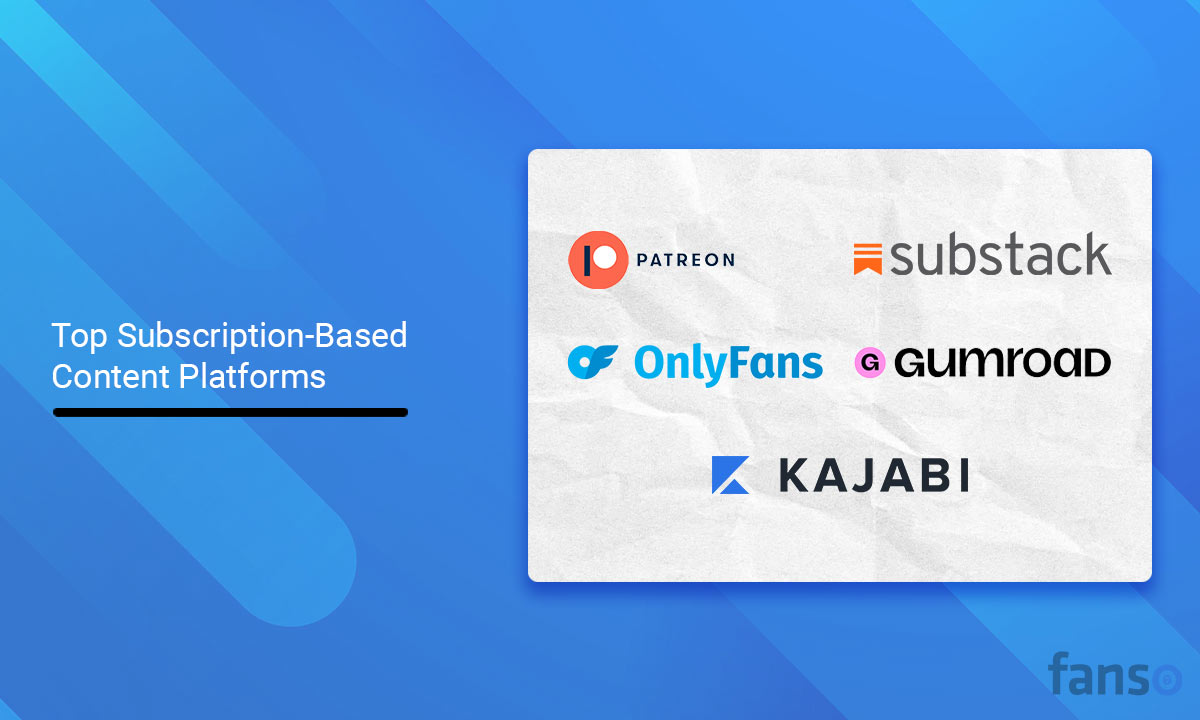Are you looking to make your journey from passion to profit easier with subscriptions? Then, choosing the right subscription platform is your way to thrive in the creator economy!
According to UBS Wealth management report, the subscription economy is set to reach the $1.5 trillion mark by 2025. So, this is definitely the right moment to step in!
In this blog, we have covered all the top subscription-based content platforms to make your call on scaling your content creation business!
Whether you’re a writer, video, music artist, coach, podcaster, video producer, or any other creative mind, this blog will help you find the right platform!
Table of Contents
- 1 Is the Subscription Model Still Viable?
- 2 What are the Different Types of Subscription-Based Content Platforms?
- 3 10 Best Subscription Platforms for Creators
- 4 How to Choose the Right Subscription Platform?
- 5 Ready to Grow Your Subscription Business?
- 6 FAQ-Related to Top Subscription-Based Content Platforms
Is the Subscription Model Still Viable?
Subscriptions are everywhere, from accessing online courses to your much-awaited newsletters. But is it still profitable enough?
Yes, it’s still a scalable business model to earn recurring revenue. The subscription economy is projected to reach $2.3 trillion by 2028; this proves that subscriptions still capture the “zeitgeist” of the creator economy.
So, why are subscription models still viable?
First, they offer convenience by eliminating the need for frequent purchases or manual scheduling. Subscriptions also offer the flexibility of choosing the frequency of subscription services and pausing or cancelling them.
The predictable revenue is a given offering financial stability for your business. Subscriptions offer value-driven and personalized subscription experiences, driving a higher customer lifecycle(CLV). Loyal customers turn into repeat customers, lowering the overall customer acquisition cost.
Simply put, it values flexibility over ownership, appealing to customers!
Pro Tip: 💡 Pro Tip: Stepping beyond and starting your own subscription-website? Get practical advice and tips on how to start a subscription website with top-notch features.
What are the Different Types of Subscription-Based Content Platforms?
The subscription model is perfect for offering unique experiences and monetizing exclusive content. Based on the content type, here are the different types of subscription-based platforms:
-
Community-Focused Content Platforms
All-in-one community platforms like Circle, Mighty Networks offer tools to build close-knit communities. Users of similar interests can interact, share content, and find ways to monetize it.
-
Online Course Platforms
Platforms like Thinkific, Kajabi, Teachable, and Podia allow creators to create and sell courses and also focus on building their brand.
-
Newsletters & Publications
Publishing platforms like Substack and Ghost help writers, journalists and bloggers to connect with their readers. They offer a sophisticated suite of tools to create and share newsletters, podcasts, videos, etc.
-
E-commerce Platforms
Woocommerce, Magento, and Shopify are subscription plugins that allow businesses to sell one-time purchases and subscription-based products.
-
Patronage Platforms
Patreon and Ko-Fi are digital support platforms where creators can fund their projects with pledges, subscriptions, or selling digital products. In return, the platform charges a flat fee on earnings.
10 Best Subscription Platforms for Creators
Given below are the best subscription platforms for different types of subscription businesses creators:
| Subscription Platform | Creator Category | Payout |
| Patreon | Musicians, podcasts, & content creators | 8-12% of earnings |
| OnlyFans | Adult performers, fitness creators, musicians, gamers | 20% of creator earnings |
| Cameo | Celebrities & influencers | 25% of earnings |
| FanCentro | Primarily for adult creators | 20% of earnings |
| Fansly | Primarily for adult creators | 20% of earnings |
| Substack | Writers, bloggers, journalists, podcasters, videographers | 10% of earnings |
| Kajabi | Course creators & entrepreneurs | From $89/month |
| Podia | Course creators, coaches, entrepreneurs | From $33/month |
| Thinkific | Content creators | From $4/month |
Here’s a quick rundown of the top subscription-based content platforms and what they are best for:
1. Patreon – Best for Music Artists, Podcasters, and Content Creators
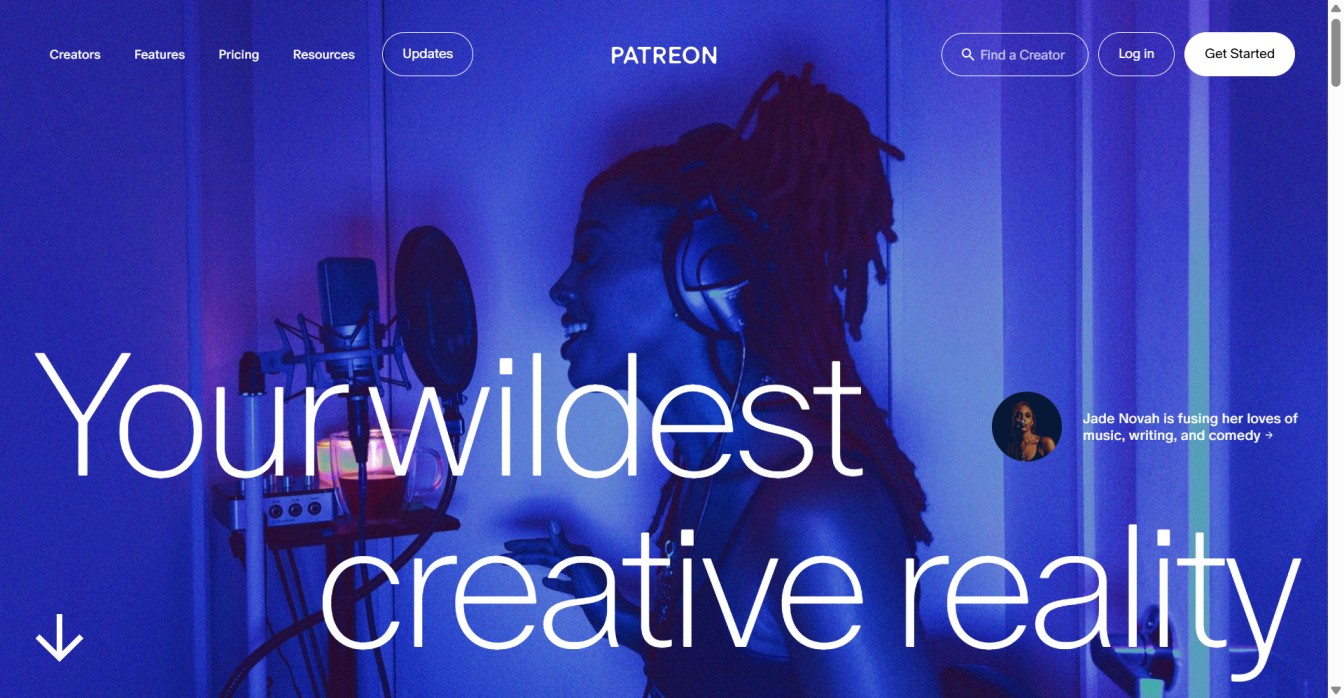
Shattering the myth of “starving artists”, Patreon defined the trend of fans supporting their favourite artists through pledges. It’s a well-known platform where creators can monetize from unique membership tiers and digital products.
The platform offers a creator page and community-building tools to manage memberships and communicate with fans. Creators can start their channels independently or as a team. Next, they can offer a diverse range of content, including text, photos, videos, polls, live events, podcasts, or even music albums.
Offering merch is like a breeze on Patreon! Choose a unique design and your preferred merch items, such as mug, bags, poster, t-shirts, hoodie, prints, etc. Patreon makes your work easier by recommending the tiers for merch and managing the shipping and production.
Pricing
Starting a Patreon page is free for creators.
However, it takes a sales cut 8-12% from creator earnings. You can choose a plan based on your earnings.
Pro (8% of your income) – Access a core set of Patreon tools, such as membership tiers, free trials, offers, engagement tools, member analytics and insights.
Premium (12% of your income) – Everything from pro; access enhanced set of tools including merch for membership, partner manager, etc.
Patreon Paid Membership Pricing
Pros
- Multi-tiered subscription plans
- Recurring income from exclusive content and selling digital products
- Community building and engagement tools like community chats, discord, etc.
- Manage merch for membership
Cons
- High sales cut on creator earnings
- Extensive competition due to its popularity
- Less ownership of your business
⚡ Related Reads: Here’s our comprehensive blogs to understand Patreon better:
2. OnlyFans – Best Subscription Platform for Adult Creators
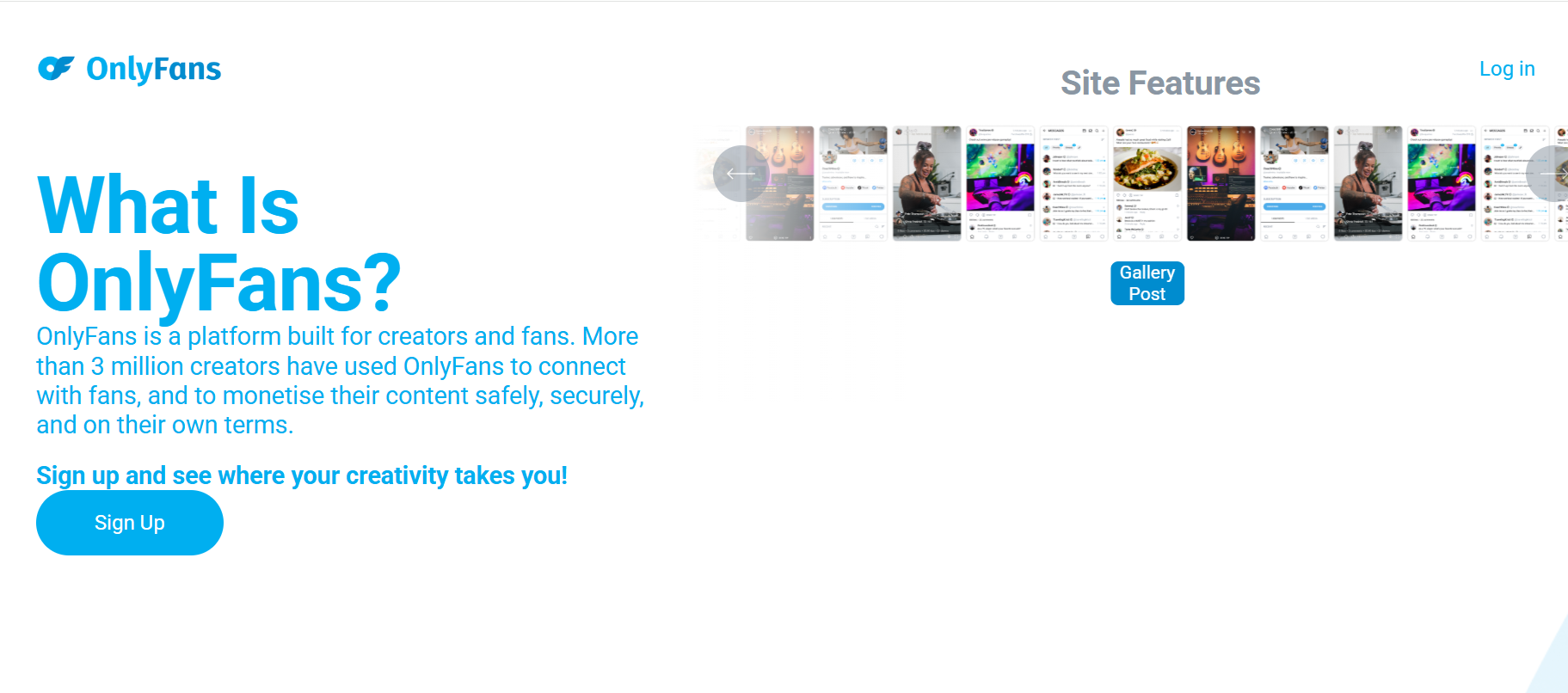
Founded in 2016 by Tim Stokely, OnlyFans is a social content subscription platform that needs no introduction! While it’s synonymous with adult content, OnlyFans supports diverse niches, such as gaming, fitness, music, etc.
Creators can make money on OnlyFans from subscriptions, tipping, paywalled content, livestreams, custom content, selling merchandise, etc. In exchange for content autonomy and popularity, the platform charges a 20% commission cut on creator transactions.
You must be at least 18 years of age to join the platform(both creators and subscribers). The platform has a strict identification & age verification process, to create a safe environment for creators. Social media platforms like X, Instagram, Reddit, and Facebook are great to promote OnlyFans content.
Pricing
OnlyFans takes a 20% sales cut on every platform transaction, including subscriptions, PPV, live streaming, tipping, merch, and direct messaging.
Pros
- Passive income stream
- Diverse monetization streams
- Go-to platform for adult content creators
- Complete content autonomy
- Easy-to-use interface
Cons
- Strict age and identity verification regulations
- Risk of content leaks, piracy and identity thefts due to adult nature
- Competitive and difficult attract drive conversions
Pro Tip: 📖 Planning to create your own OnlyFans-like website? Learn the right steps to build an OnlyFans alternative and maximize profits.
3. Cameo – Best video shoutout platform for celebrities
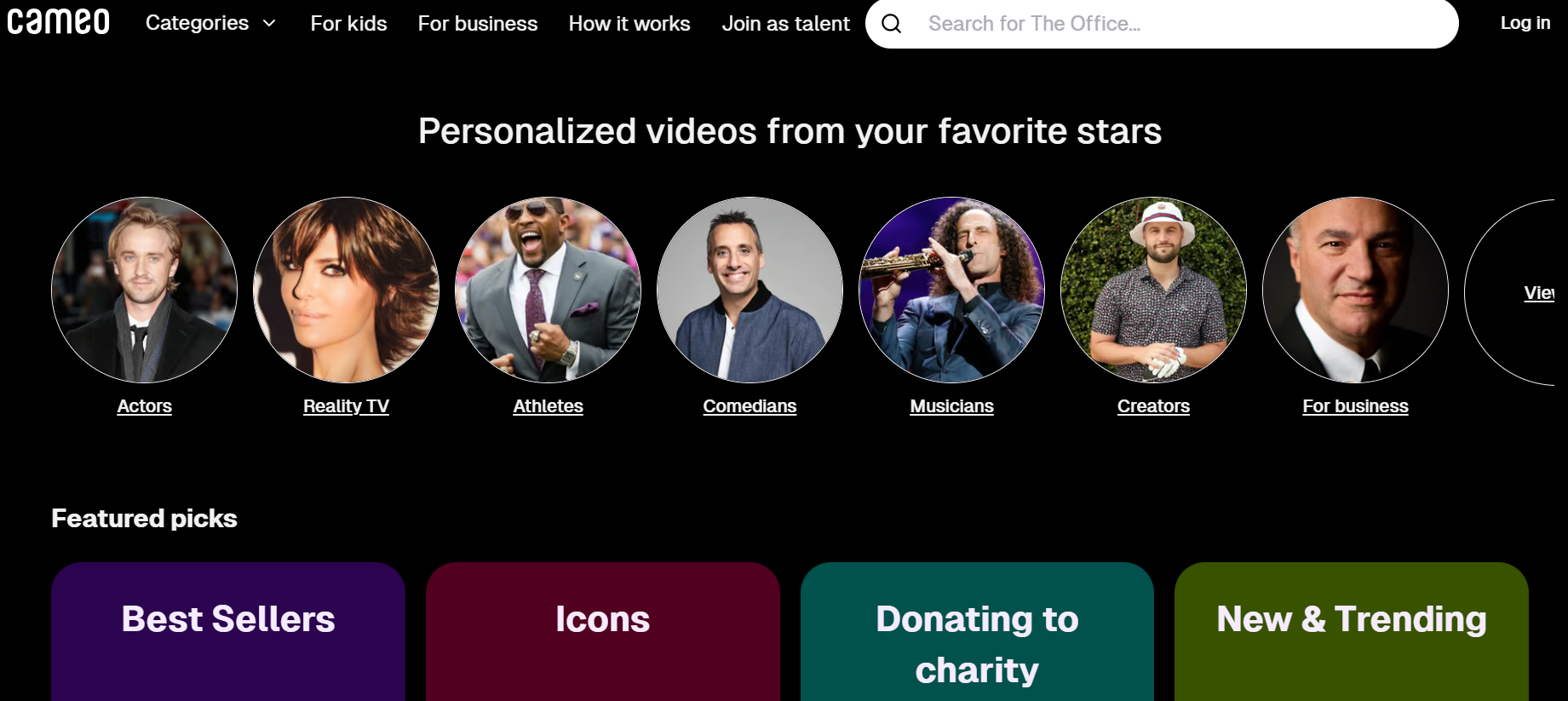
Cameo is a popular video shoutout platform for creating personalized celebrity videos for special occasions. This could be for different occasions, such as birthdays, anniversaries, milestones, or even a well-deserved roast!
Featuring a long-list of celebrities, including B-list actors,comedians, social media influencers, athletes, Cameo is great for forging fan-creator connections. Once fans discover their favourite celebrities, they can request a personalized video with customized instructions.
Fans can receive their personalized videos within 7 days which they can later share and download. Apart from the video requests, celebrities can monetize from 1-on-1 cameo calls, paid DMs, merchandise.
Cameo Business offers celebrity-driven promotions for marketing campaigns and product launches.
Pricing
Cameo charges a 25% commission on celebrity earnings, and the celebrities earn the remaining 75%.
Pros
- Offers personalized videos, 1-on-1 calls, and DMs for connecting for fan-creator interactions
- Flexible pricing options, including pay-per-video or subscriptions for creators
- Fans get exclusive feed access, staying informed about price drops, promotions, or content updates
- Customized requests for birthdays, special occasions, pep talks, etc.
Cons
- Exclusively for celebrities and influencers
- Charges a hefty 25% commission on celebrity earnings
⚡ Related Reads: Learn more about Cameo and its business model from our detailed blog.
4. FanCentro – Best Uncensored Adult Content Platform
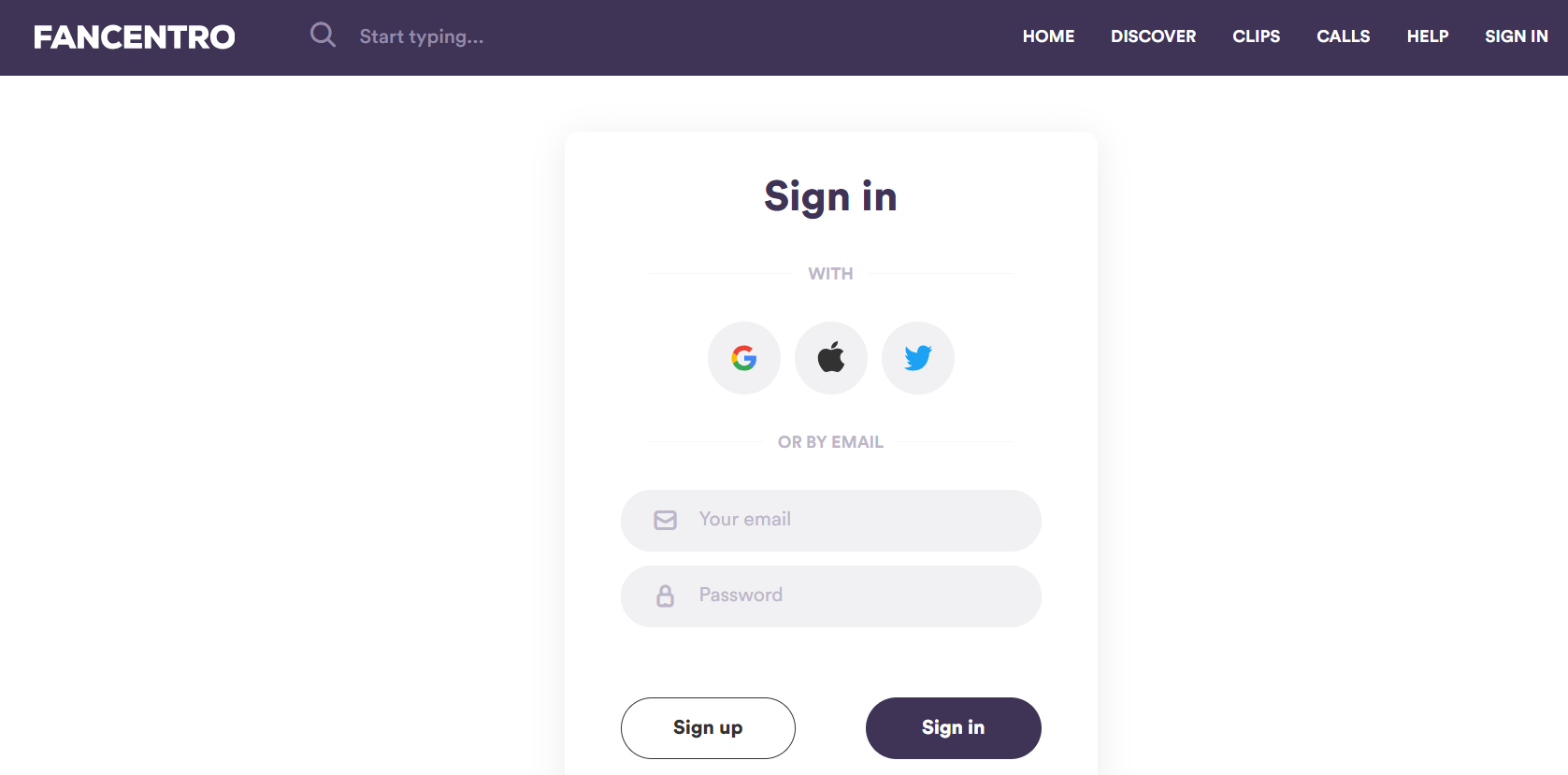
Another uncensored adult content platform, Fancentro, offers different tools and features for adult performers. Actors, social media influencers, and models can join the platform and monetize from exclusive content.
Creators can monetize from subscriptions, pay-per-view posts, messaging, private social media accounts. Livestreams, content feeds, stories, DMs, clips, are different ways to share content and connect with your fanbase.
If you’re looking to join from other creator platforms, FanCentro offers easy migration support to avoid losing any information!
Pricing
Creators can earn 80% of their payouts; the remaining 20% goes to FanCentro
Pros
- Easy migration from other content platforms
- Earn from subscriptions, pay-per-view, messaging, private social media accounts
- Centro University offering free model and influencer training program
- Referral program offering 10% of FanCentro’s revenue share for every referred creator
- Sophisticated content discovery feature to find creators based on specific filters
Cons
- Not as popular as OnlyFans offering less exposure to platform creators
💡 Want to find which one is better? Find the right platform with our OnlyFans vs. FanCentro comparison guide.
5. Fansly – Best Adult Content Platform with Unique Subscription Tiers

Fansly is primarily an adult content subscription platform and a great alternative to OnlyFans. OnlyFans’ significant rival offers a more user-friendly interface and flexible discovery tool.
Like OnlyFans, Fansly is open to a broad range of niches, from gaming to fitness. Creators can monetize on Fansly from subscriptions, pay-per-view content, livestreams, messaging, etc.
Fansly allows creators to set up multi-tier subscriptions with unique perks, unlike OnlyFans basic subscription. The FYP page is the platform’s robust content discovery system offering curated creator suggestions.
Post scheduling, targeted geo-blocking, eye-catching thumbnails, and a no-chargeback policy are a few additional platform-specific features.
Pricing
Fansly takes a 20% cut from every creator transaction, and the remaining 80% earnings goes to creators.
Pros
- Multiple Subscription tiers
- Built-in marketing tools like FYP page
- Creator-friendly features
- Advanced security features, such as geo-blocking, watermarking, secure payment processing
Cons
- Smaller user base & platform size compared to OnlyFans
- Need extensive social media promotion to build an audience
6. Substack – Best for Writers, Bloggers, Podcasters
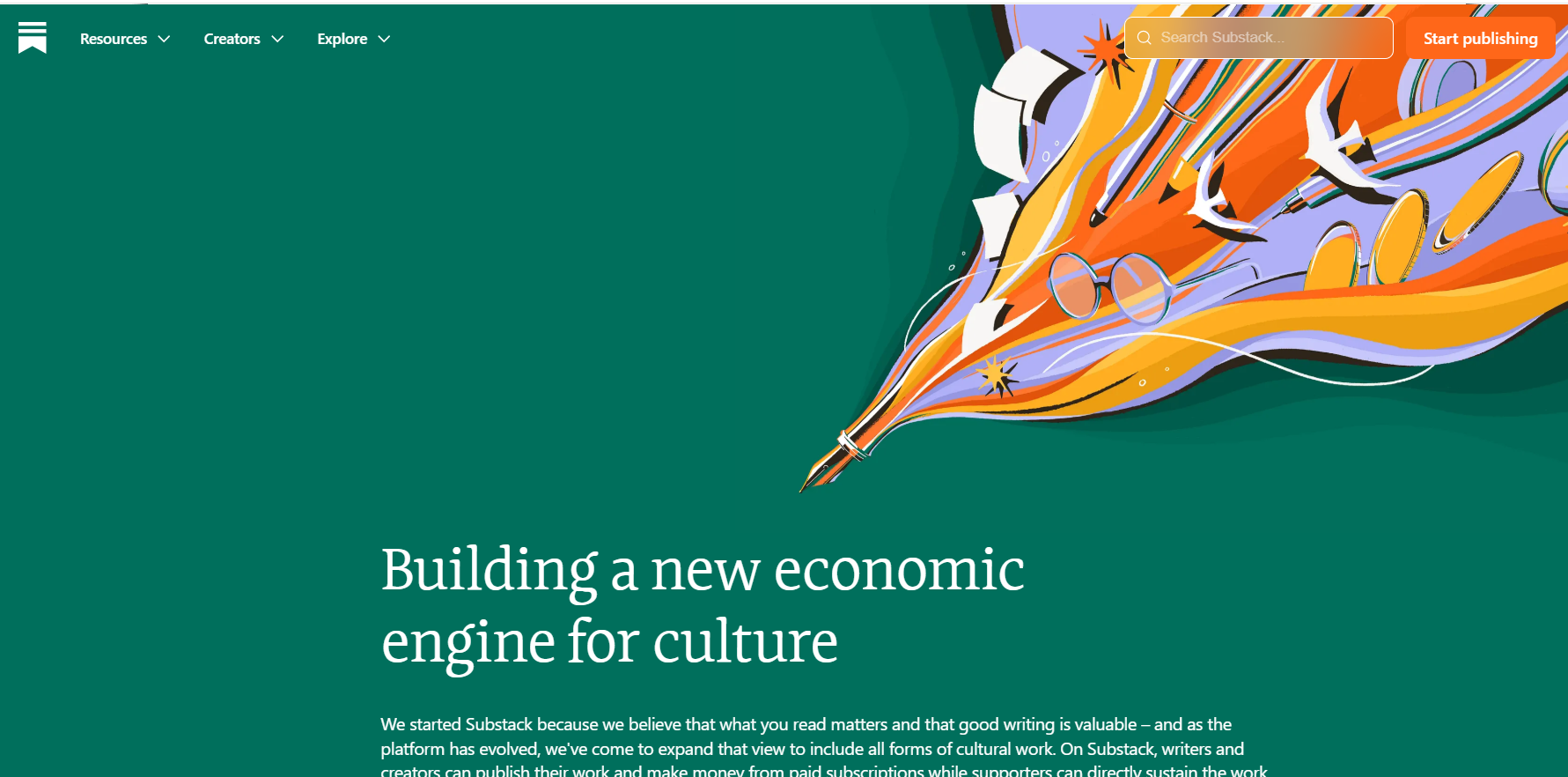
Enter Substack, the paid newsletter platform has welcomed a new era for the creative writing minds. Whether you’re an aspiring writer, blogger, journalist, or author, it helps to monetize by delivering power-packed newsletters straight into your readers inbox.
Apart from text posts, creators can also publish discussion threads, podcasts and videos. Its powerful feature set includes a website, community tools, podcast hosting, analytics, etc. You can choose to offer either free or paid newsletters while the platform earns a percentage.
Want to build your brand? You don’t need to be a HTML pro to customize your newsletters on Substack. The platform offers options to personalize your newsletters with various colors, backgrounds, fonts, etc.
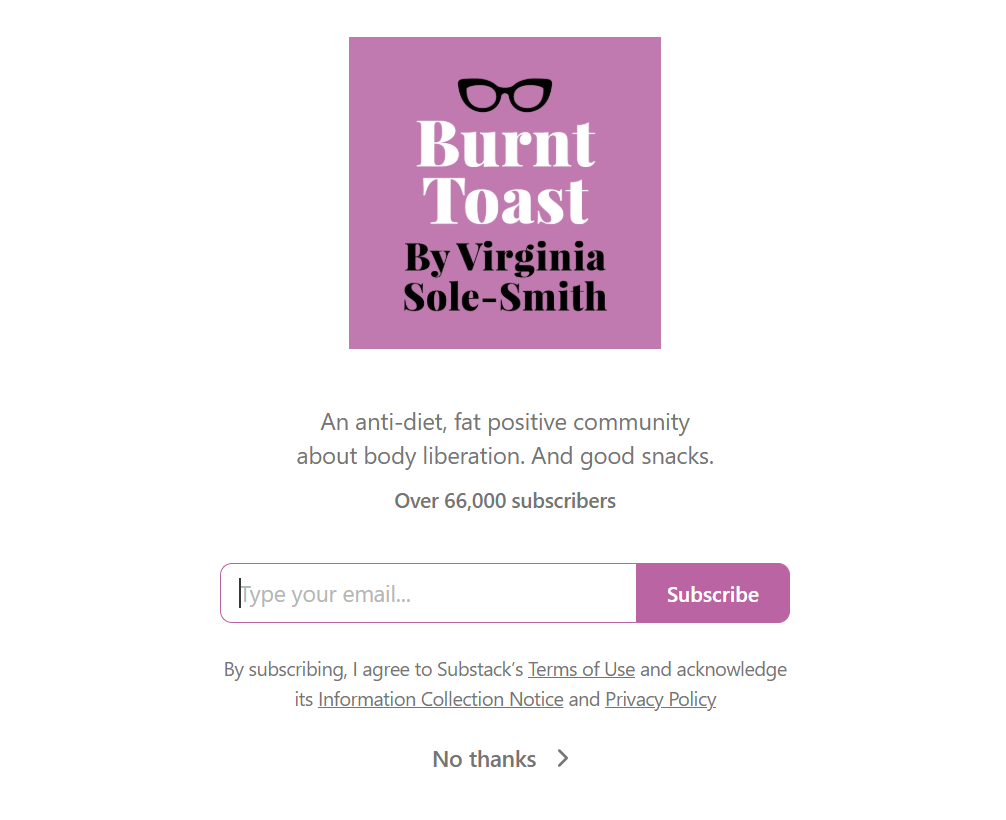
Publishers can set three tiers: monthly, yearly, or founding member subscription tiers. The subscription tiers start as low as $5 per month. Some even offer the first newsletter for free and encourage readers to subscribe for the next one.
Until now, it boasts over 35 million active monthly subscribers and 3 million paid subscriptions, building a new economic engine for culture.
Pricing
Substack takes a 10% fee on subscriptions payments. For free newsletters, publishing is free.
Pros
- Easy-to-use tool for writers and bloggers doesn’t require technical expertise
- Monetize from paid newsletters without relying on ads
- Supports diverse content types, such as text posts, podcasts, videos, threads
- No algorithm between you and your readers
- Rank your newsletters on search engine with its built-in SEO features
Cons
- Charges hefty 10% cut for paid newsletters
- Limited website customizations
- Cannot replace your conventional email marketing service
- Less signup or segmentation options
7. Kajabi – Best for Comprehensive Marketing and Sales Features
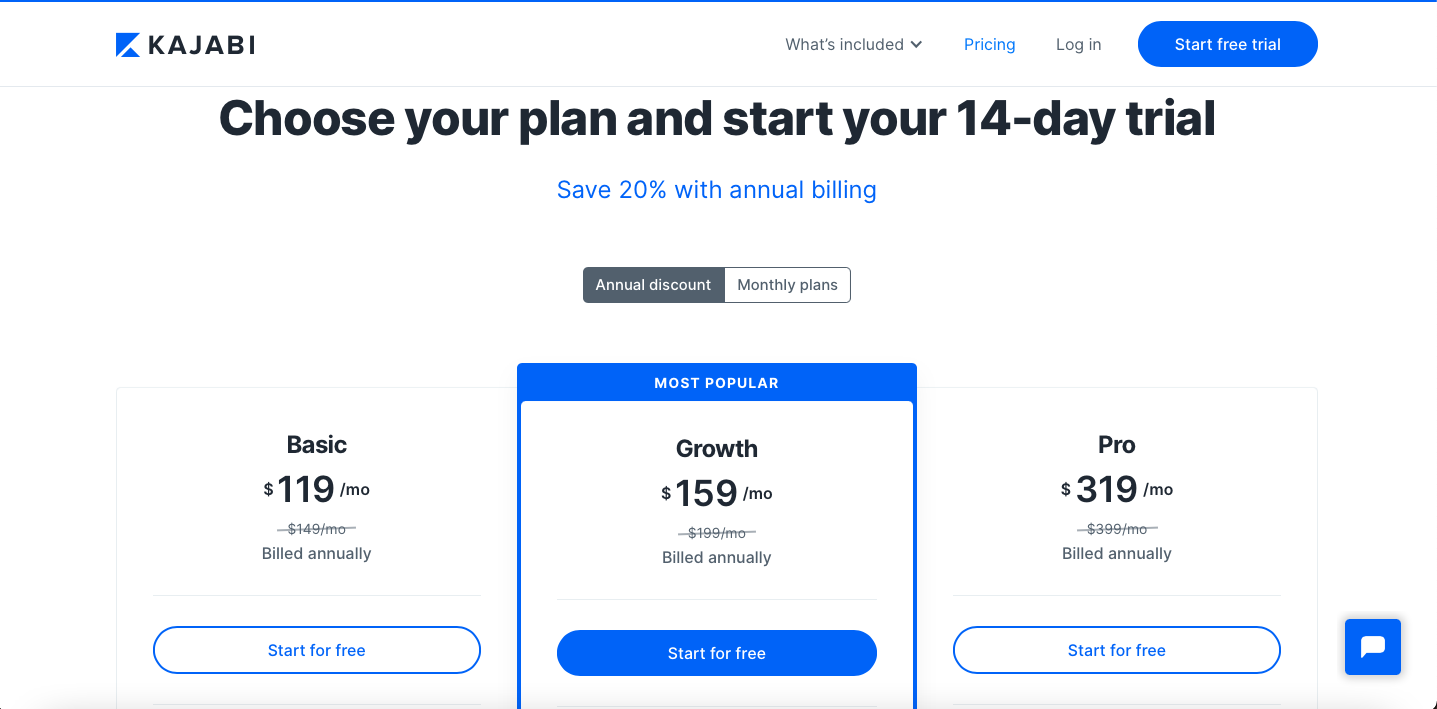
Are you looking for an all-in-one course platform with a strong marketing funnel?
Kajabi’s comprehensive marketing suite makes it one of the top subscription-based content platforms. It allows you to build a community centred around your course!
Creators and entrepreneurs can sell digital courses, memberships, coaching sessions, and digital products on the platform. The platform offers features like an easy-to-use course builder, website builder, landing pages, email campaigns, triggers, upsells and downsells.
One thing the platform excels in is marketing funnels – blending the magic of landing pages and email campaigns driving a prospect to purchase! It offers 7 pre-built funnel templates for different scenarios: from launch to seamless sales funnels!
Kajabi is also great for growing your business with support for over 20+ third-party integrations, including Mailchimp, Zapier, Hubspot, WordPress, etc. Simply put, Kajabi offers everything to create, sell and market your courses, memberships and products, all in one place.
Pricing
Kajabi’s offers 4 plans with a 14-day free trial:
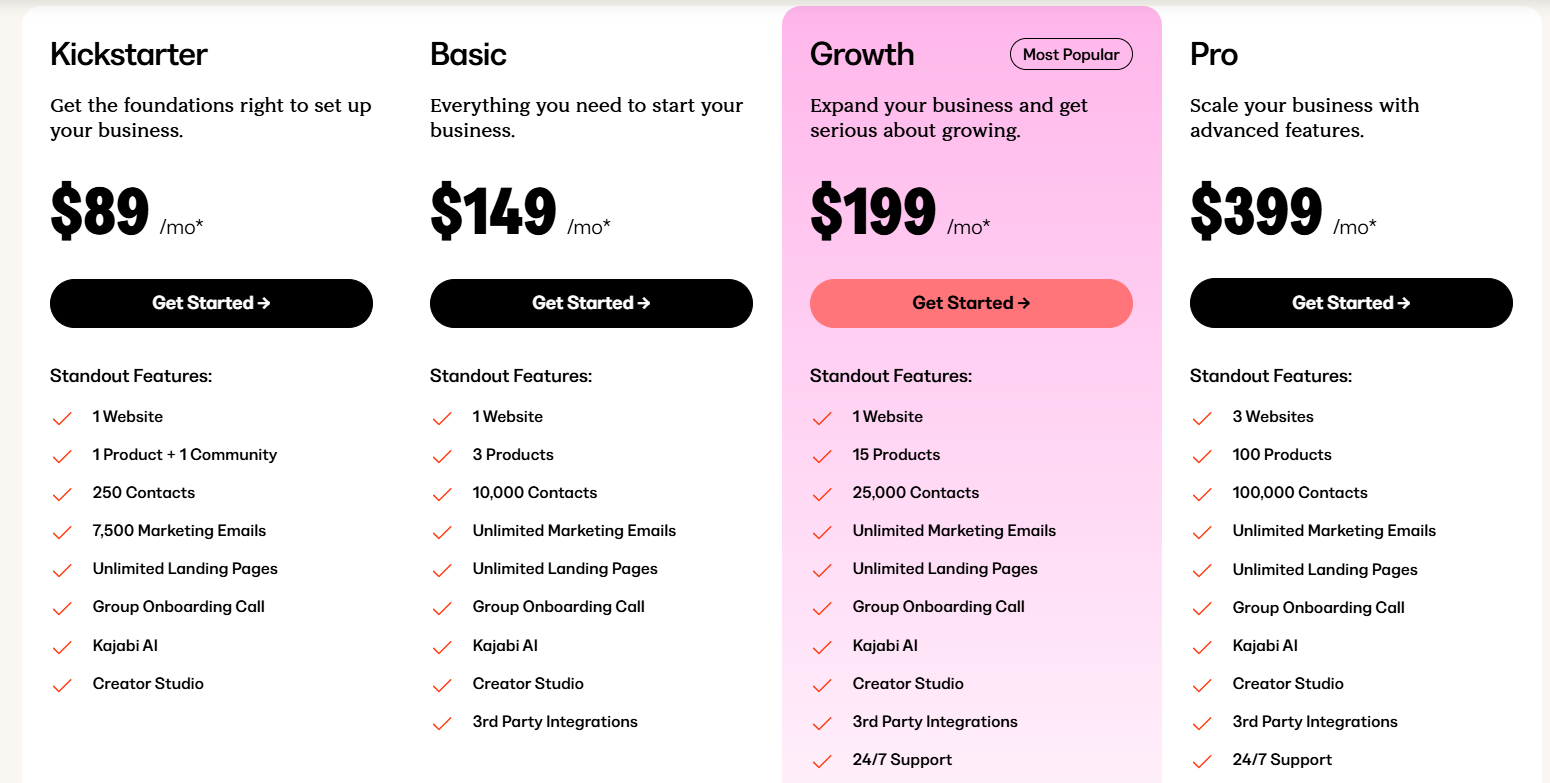
- Kickstarter ($89/month) – 1 website, 1 product + 1 community, 7,500 marketing funnels, landing pages
- Basic ($199/month) – 1 website, 3 products, unlimited marketing funnels & landing pages, 3rd party integrations
- Growth ($199/month & most popular) – 1 website, 15 products, unlimited marketing funnels & landing pages, 3rd party integrations, 24/7 support
- Pro ($399/month) – 3 websites, 100 products, unlimited marketing funnels & landing pages, 3rd party integrations, 24/7 support
Pros
- Dedicated course platform with easy course builder, broad content support, AI recommendations
- Connects to email and landing pages
- Detailed analytics for courses, memberships, and digital products
- Mobile support
- Strong community support and resource access
Cons
- Emphasizes more course creation and less on membership site builder
- High-end pricing plan
- No free plan, only a 14-day free trial
8. Podia – Best for Selling Coaching Sessions
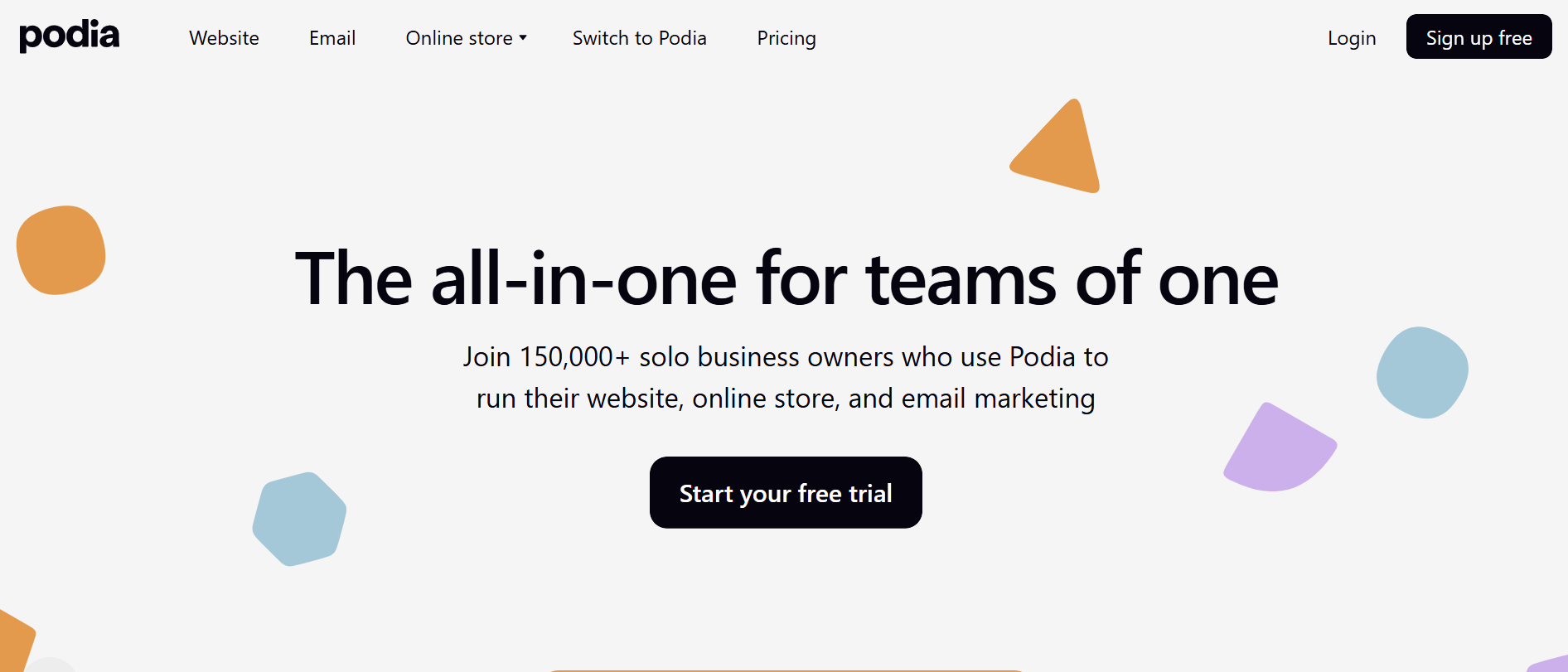
The next one is yet another all-in-one platform for selling courses, memberships, and downloads, all from a single dashboard. Podia is a great platform for course creation, taking away all the stress from course-building and focusing on complex business aspects.
Podia’s drag-and-drop website builder is great for building online storefront. From multimedia support to video hosting and landing pages, it keeps the coding hassles out of your way!
Now, let’s move to the course creation aspect! Streamline your course creation by uploading and structuring your lessons, embedding multimedia, setting up drip schedules, and adding quizzes.
If you host webinars and live sessions frequently, Podia allows you to set up and manage Zoom and YouTube live sessions. This makes it a great platform for coaches! Plus, there’s a separate section for creating new coaching products.
Pricing
You can start Podia with a 30-day free trial.
Below, are its two different pricing plans:
- Mover ($33/month; cuts 5% transaction fees) – Website, online store, email marketing, unlimited products, 7-days customer support , custom domain
- Shaker ($75/ month)– Website, online store, email marketing, unlimited products, blog, custom domain, 7-days customer support, affiliate marketing
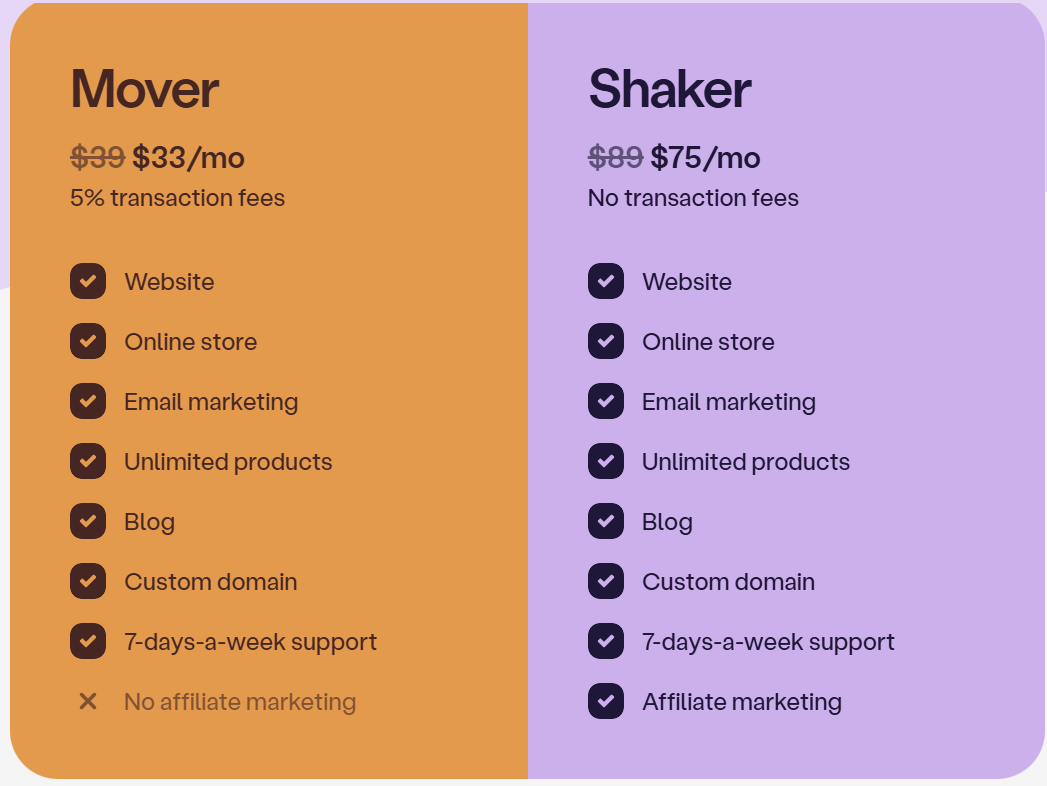
Pros
- All-in-one platform for selling courses, memberships, digital products
- Drag-and-drop website builder with templates and customizations
- Easy course builder with drip scheduling, bundles, and pre-selling options
- Build free or paid communities for discussions, sharing, and user interactions
- Support for a broad range of digital products
Cons
- No support for selling physical products
- Limited customization to control your storefront
- No mobile app
- Lacks advanced features for website building
9. Gumroad- Best E-commerce Platform for Creators
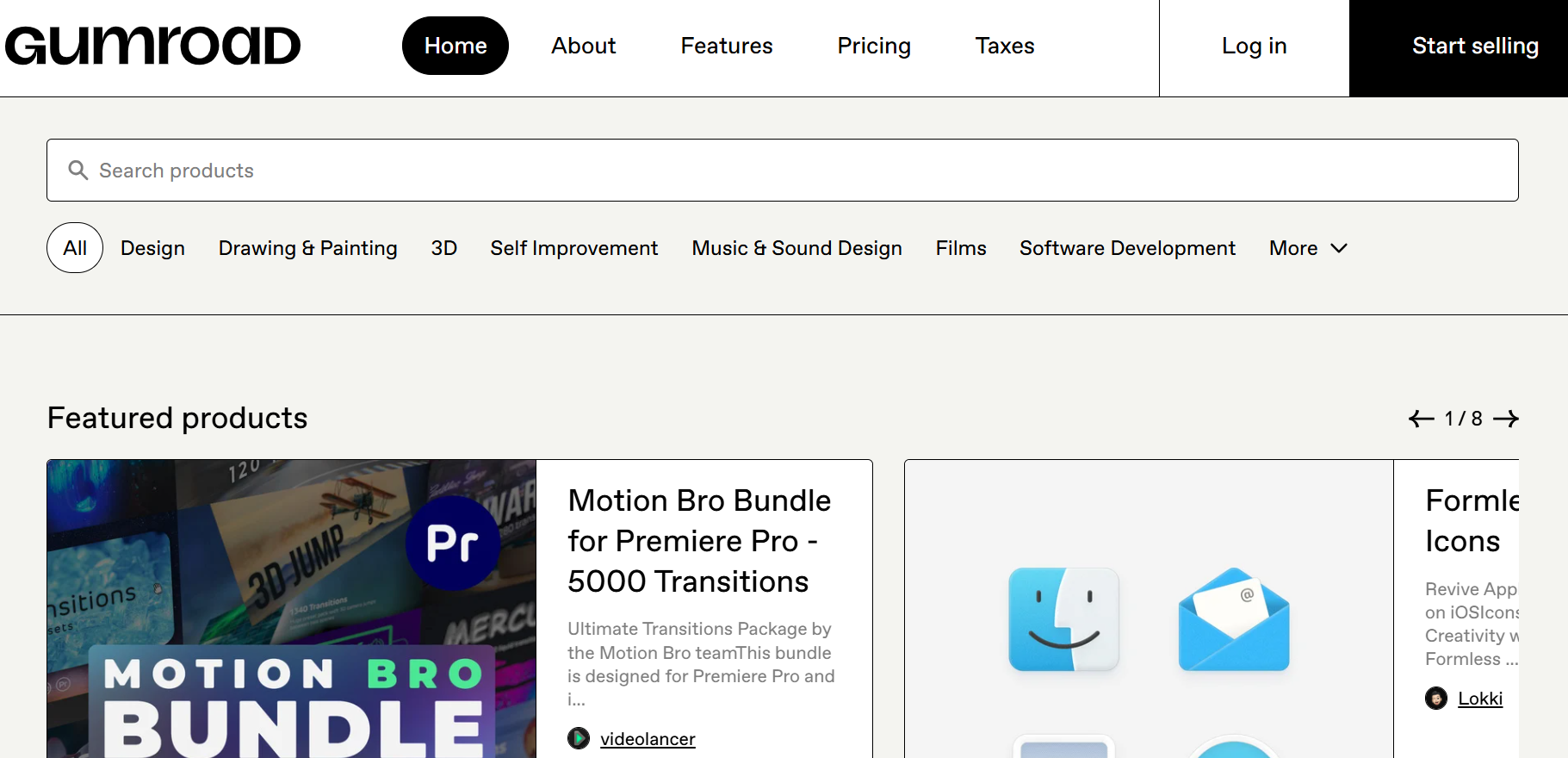
Gumroad is one of the powerful e-commerce platforms for selling digital products, courses, memberships, and more. Creators can join the platform and start selling digital products like e-books, music, software,courses, and other digital content.
So, what makes Gumroad different from traditional e-commerce platforms? The ease-of-use and simplicity to start your digital storefront often makes selling digital products like a breeze. So, anyone can start a store on the platform or embed into their website!
Creators can set up monthly, quarterly, yearly, or biannual membership tiers and start listing their digital products. You can maximize your earnings using features like bundling, discount codes, pricing flexibility, etc.
And for those who want to escape the marketing grind, the built-in marketing tools do the work! From landing page and sales tracking to payment processing, Gumroad has a tool for everything!
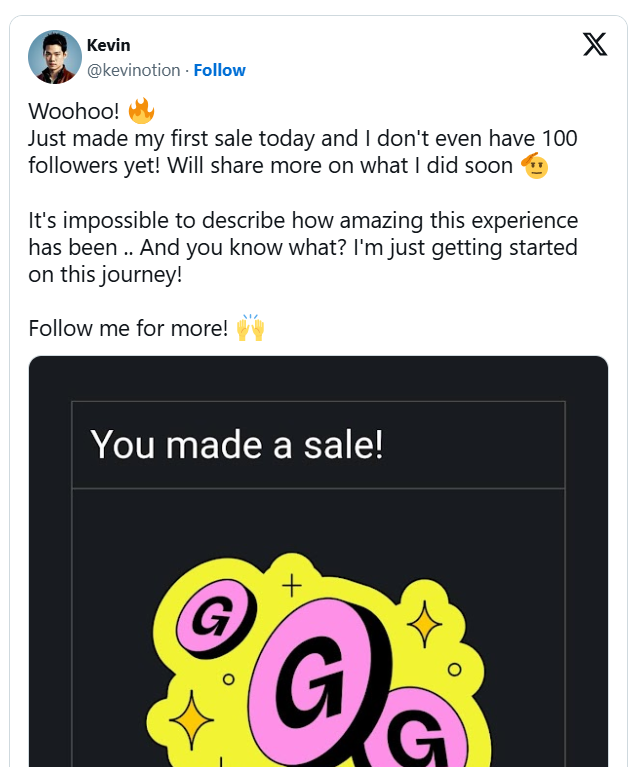
Pricing
Gumroad doesn’t charge a monthly platform fee. Instead, deducts a 10% transaction fee from every sale minus the standard processing charges.
Pros
- Sell both digital & physical products
- Built-in marketing features like bundling, discount codes, etc
- Auto-generated links to easily integrate your Gumroad store into your blog or website
- Flexible pricing with one-time payments, subscriptions, memberships, discounts, etc.
- Impressive statistics and analytics features to analyze your customer information
Cons
- Not recommended to manage multiple products
- Limited customization for sales and checkout pages
- No trial packages
- Only supports major credit cards and PayPal; it doesn’t support Apple Pay, Payoneer, and other forms of payment
10. Thinkific – Best All-in-Course Platform for Creators
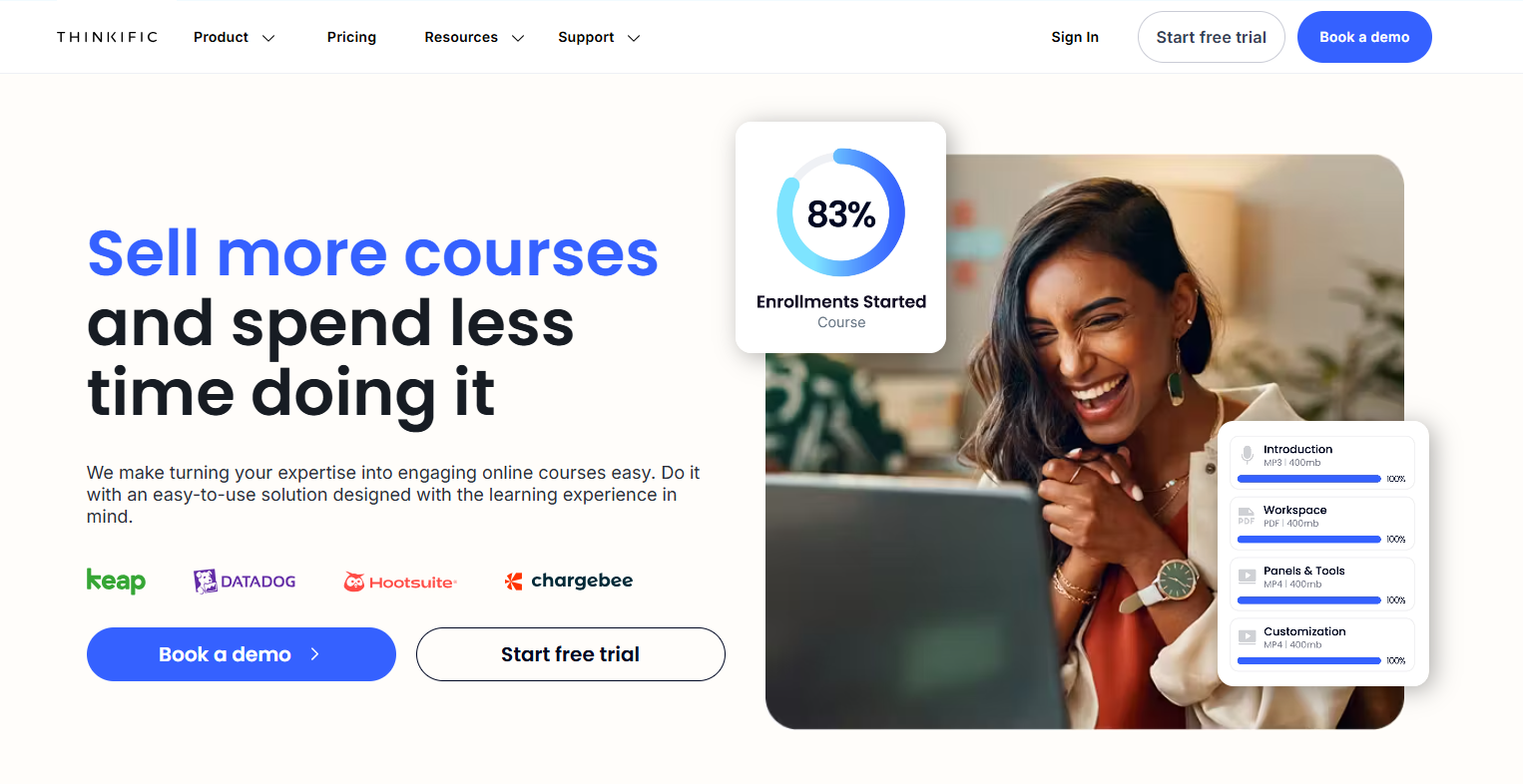
Here comes the last pick, Thinkific, an all-in-one course platform for educators, entrepreneurs, and authors. If you have some wisdom to share with the world, Thinkific offers tools to take the first step into product creation!
Creators or niche experts can build courses or communities to make a robust business out of it! The intuitive course builder covers all the fundamental tools for course creation.
On top of that, it offers a drag-and-drop website builder for seamless homepages and landing pages.
Creators can engage learners with quizzes, assessments, live lessons and events. Thinkific communities are shared online spaces for engaging learners, facilitating powerful interactions, etc.
Lastly, Thinkific analytics helps to track student engagement and revenue growth and refine marketing strategies. Thinkific plus, the platform’s enterprise version, offers extensive training to employees and customers.
Pricing
Thinkific offers 4 different pricing plans:
Basic ($4/month) – Unlimited courses, website builder, 1 community, 5 digital downloads, 5 coaching & webinar sessions, order bumps, abandonment cart
Start ($99/month)– Same as basic plan; plus unlimited courses, unlimited digital downloads, bundles & add-on packages, live lessons & memberships, advanced CSS/ HTML editing
Grow ($199/month) – Same as Start plan; 3 communities, plus feature to remove thinkific branding, group orders, thinkific analytics
Thinkific + (custom-pricing) – All thinkific features, and unlock advanced enterprise-level features & integrations
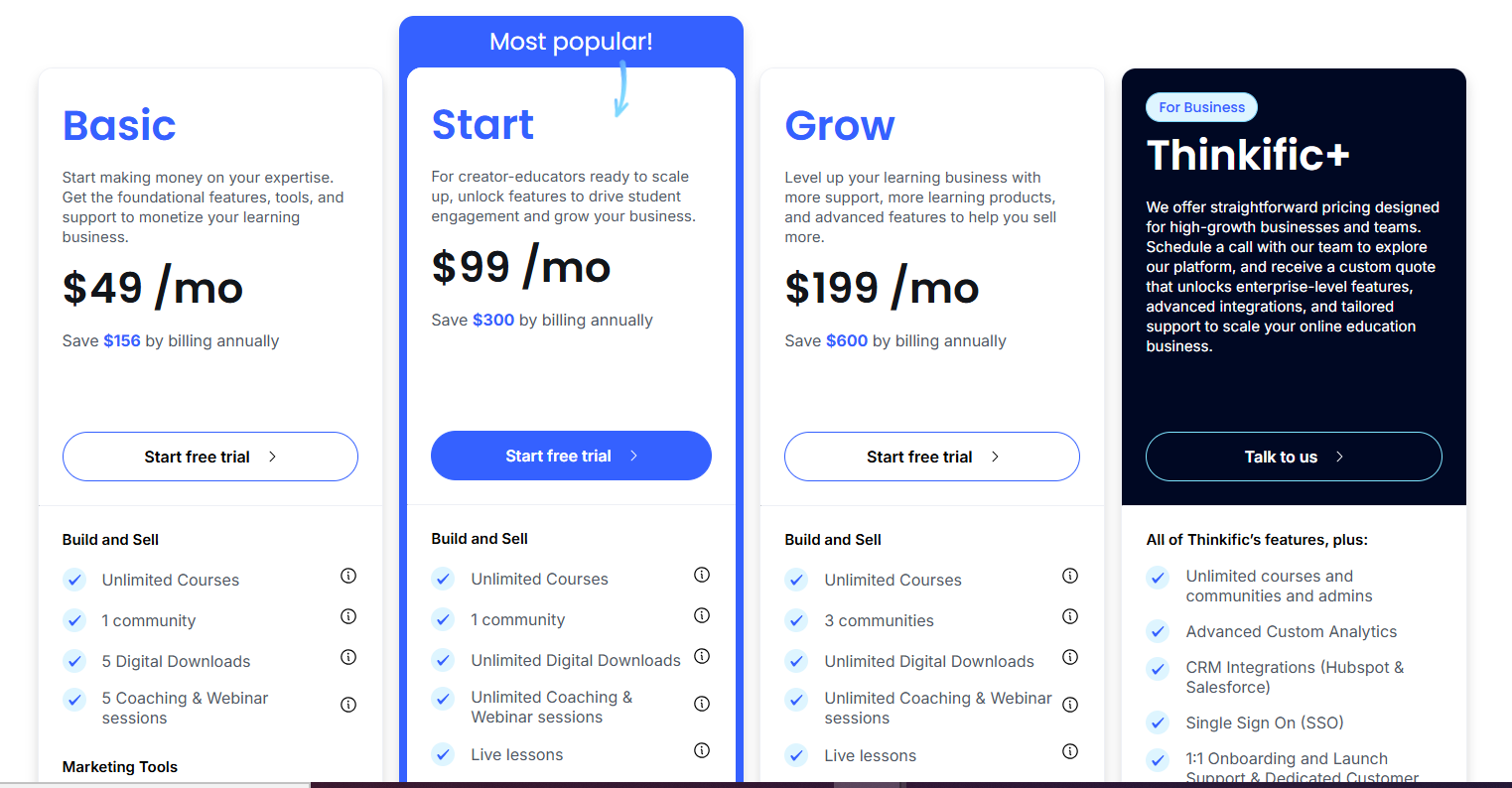
Pros
- User-friendly interface and minimal learning curve
- A broad range of third-party integrations like Zapier, Mailchimp, Google Analytics, and more
- Excellent customer support through live chat, email, and help guides
- Scalable overtime to add more courses, products, and memberships
Cons
- No free plan
- No built-in integrated email marketing or cart sequences
- Lacks marketing sales funnels, built-in blogging tool
- Limited customization for website & design
Other subscription-based content platforms:
- Memberful
- Skool
- Sellfy
- Shopify
- Circle
Well that’s the top subscription-based content platforms to kickstart content creation!
How to Choose the Right Subscription Platform?
Choosing the right subscription platform is a crucial decision to tap into the right audience and grow your business.
These are factors you should consider to pick the right platform:
- Subscription-management – Opt for platforms with mult-tier subscription tiers, auto-renewals, upsells, downselling, for better customer experience.
- Flexible payment & billing – Evaluate features, such as one-time payments, recurring billing, discount codes and bundling to drive more conversions.
- Scalability – Your subscription platform should be able to adapt to peak loads, optimize your performance, and automate your work. Templates for marketing funnels, branding, websites, and landing pages, can reduce time and effort.
- Pricing – A transparent pricing plan offers balance between price and value. Determine if your pricing plan meets your business requirements.
- Security – Look for data encryption, access control, secure payments and compliance with industry standards in your subscription platform.
- User experience – A user-friendly interface makes selling courses, memberships, and digital products seamless.
Ready to Grow Your Subscription Business?
Choosing the right subscription-based content platform can make all the difference for your business! This blog covers the top subscription-based content platforms so you can make an informed decision.
First, figure out your realm of interest: course building, digital products, or memberships. The right subscription platform fits your business goals, budget and helps with customer management.
We hope you find this blog helpful! Good luck with your endeavour! 👍
FAQ-Related to Top Subscription-Based Content Platforms
1. What is a subscription-based platform?
A subscription-based platform is an online service allowing creators to earn a recurring income by offering exclusive content, selling digital services or unique experiences. It offers dynamic features, tools, analytics, and communities to build and engage with your audience.
2. What is the best subscription platform for creators?
Patreon, OnlyFans, Cameo, Fansly, Podia, and Gumroad are some of the best subscription platforms. When choosing a subscription platform, consider factors such as user interface, membership pricing, community-building tools, and scalability.
3. How do I choose the best subscription-based content platform?
While every creator has unique business needs and has different evaluation criteria for choosing the right platform. Subscription-management, content ownership, pricing, commissions, scalability, and ease-of-use are few factors you should consider.
4. How do I balance content creation with building an audience?
Every creator struggles with this fundamental question of maintaining the content creation balance! First, focus on creating valuable and relevant content that resonates with your audience. Be consistent with content creation. Reach out to your audience on social media, build an email list, appear on podcasts and streamline effective sales funnels.

